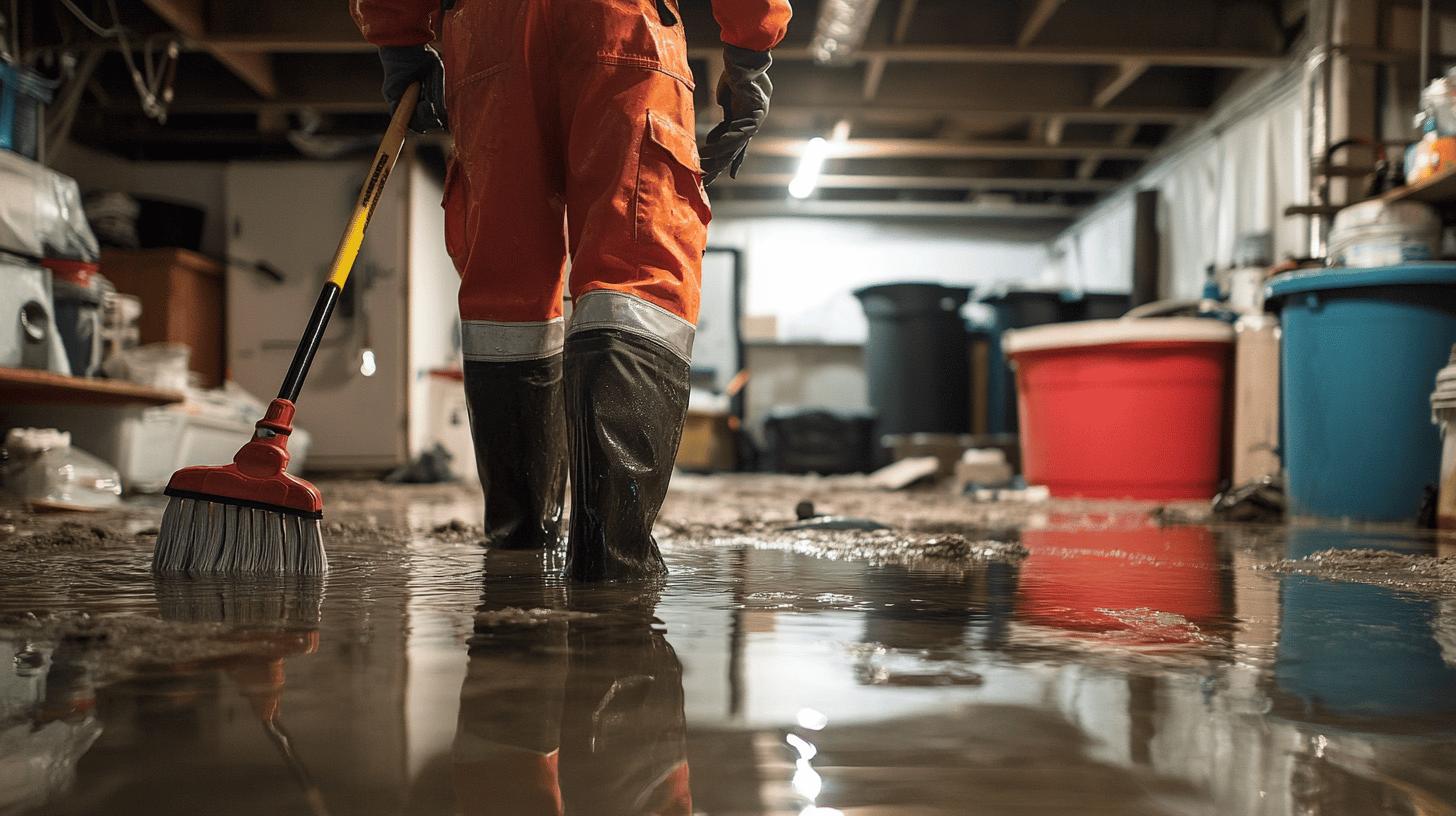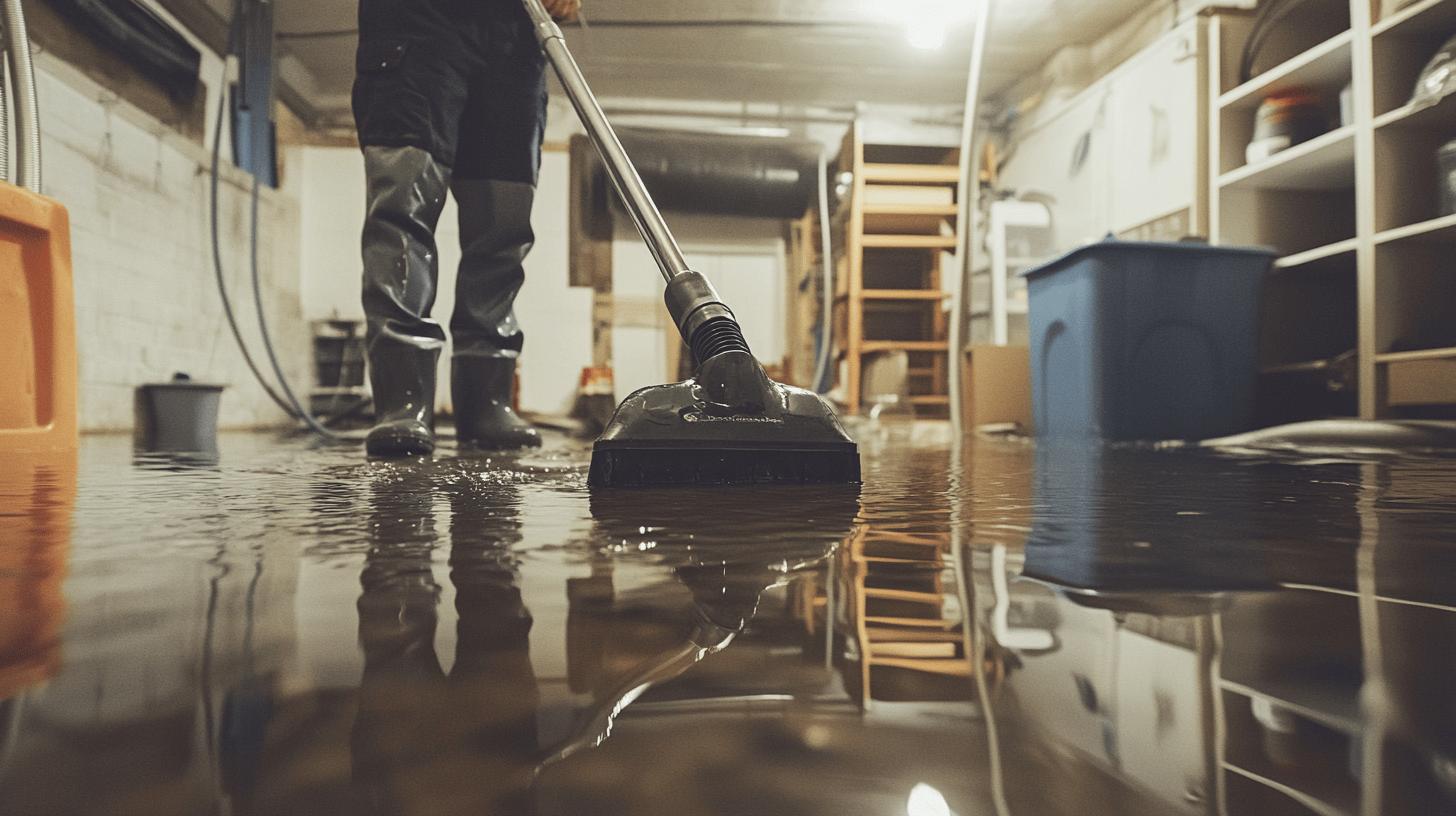TL;DR:
- Shut off electricity at the main breaker before entering a flooded basement.
- Identify and stop the water source.
- Remove valuables and water-sensitive items promptly.
- Use a gas-powered pump or wet/dry vacuum to remove standing water.
- Dry the area using dehumidifiers and fans; check dryness with moisture meters.
- Discard moisture-retaining items like drywall and cardboard.
- Clean surfaces with a bleach solution (1 cup bleach per gallon of water).
- Consider professional flood cleanup services to ensure thorough restoration.
- Implement drainage solutions and waterproofing measures for long-term prevention.
- Document damage and check insurance coverage for claims on flooding.
Is your basement flooded and you don’t know what to do? You need to act fast to avoid serious damage and health risks. First, turn off the electricity to prevent any shocks. Next, stop the source of the water and take out any valuable items. This guide will help you handle your flooded basement quickly and safely. Let’s minimize the damage and keep your home secure!
Immediate Actions for a Flooded Basement
When your basement floods, the first thing you need to do is shut off the electricity. It can be really dangerous to go into a flooded area because of the risk of electric shock. Turn off the power at the main breaker or contact your utility company to cut the power at the meter. Don’t touch the water until you’re sure it’s safe.
Next, try to find and stop the water source, whether it’s a burst pipe or a leaking appliance. Stopping the water flow can help prevent more damage. After that, quickly move any valuables and items that could get ruined by the water. Focus on important things like sentimental items, important documents, and electronics.
Once it’s safe to go in, use a gas-powered pump to get rid of most of the standing water. These pumps are great for deep water. For shallower water, a wet/dry vacuum works well. Make sure you have good ventilation and wear protective gear to stay safe.
- Turn off the electricity at the main breaker or meter
- Identify and stop the water source
- Remove valuables and water-sensitive items
- Use a gas-powered pump or wet/dry vacuum to remove standing water
- Ensure proper ventilation and wear protective gear
Effective Water Removal Techniques

To remove water from a flooded basement, start with sump pumps and wet/dry vacuums. Sump pumps are great for deep floods—just place one in the lowest part of the basement. For shallower water, a wet/dry vacuum works well since it efficiently extracts water that’s only a few inches deep.
After getting rid of most of the water, dry out the basement with dehumidifiers and fans. Dehumidifiers lower humidity to prevent mold, so place them about 6-8 inches from the walls for good air circulation. Use fans to increase air movement and point them at damp areas for quicker drying.
Don’t forget to check the basement drains! Blocked drains can make water removal harder and lead to more problems. Clear any obstructions to keep water flowing smoothly, and regularly check the drains during the process to prevent future flooding.
| Tool | Use |
|——————|———————————-|
| Sump Pump | Extracts large volumes of water |
| Wet/Dry Vacuum | Handles water extraction for shallow floods |
| Dehumidifier | Reduces moisture levels in the air|
| Fans | Enhances air circulation for drying |
Cleaning and Disinfecting After a Flood
After a basement flood, it’s super important to get rid of any items that hold moisture to stop mold and mildew from growing. Things like drywall, cardboard, and insulation can trap mold spores if you don’t remove them quickly. They can lead to health problems and more damage to your home, so throw out any water-damaged items that can’t be dried and sanitized. This helps keep your space safer and mold-free.
Next, clean hard surfaces using a mix of one cup of bleach per gallon of water. This will disinfect areas and kill any mold spores or bacteria from the floodwaters. Scrub affected surfaces like walls and floors, then rinse and dry them thoroughly to prevent leftover moisture. Using fans, dehumidifiers, and opening windows can help speed up the drying process. You can also use moisture meters to check for any remaining dampness before starting repairs or restoration.
- Discard moisture-retaining items like drywall, cardboard, and insulation
- Clean hard surfaces with a bleach solution (one cup of bleach per gallon of water)
- Scrub and rinse all affected areas thoroughly
- Use fans, dehumidifiers, and open windows to dry the basement
- Check dryness with moisture meters before proceeding
Professional Flood Cleanup Services

When dealing with a flooded basement, hiring professional flood cleanup services has many benefits. These experts have the right equipment and know-how to manage cleanup and repairs effectively. They ensure your basement is thoroughly dried, cleaned, and restored, which helps reduce the risk of mold growth and structural damage. Plus, they handle hazardous materials safely, so you avoid health risks that DIY cleanup might miss. Using professionals saves you time and the stress of handling the cleanup on your own.
One great option is Dry Tech Waterproofing Solutions, which serves the Pennsylvania, New Jersey, and Delaware tri-state area. They offer a wide range of services, including basement waterproofing, crawl space repair, drainage services, foundation repair, mold remediation, and waterproofing systems for both the interior and exterior. Their comprehensive approach addresses all aspects of flood damage, providing long-term solutions to prevent future flooding. With their expertise and specialized equipment, Dry Tech can efficiently restore your basement to a safe, dry condition.
- Basement waterproofing
- Crawl space repair
- Mold remediation
- Foundation repair
Long-Term Basement Flood Prevention
To prevent basement flooding long-term, start with proper drainage solutions like French drains, drain tiles, and sump pits. These systems help manage water flow and prevent it from pooling around your foundation, significantly reducing the risk of water entering your basement.
Waterproofing is also essential. Exterior waterproofing involves applying a waterproof coating to outside walls, while interior waterproofing can use sealants or vapor barriers. Crawl space encapsulation and insulation help keep moisture out and maintain a stable temperature.
Regularly inspect and repair basement walls and floors for signs of dampness, cracks, or missing mortar. Addressing these issues quickly can prevent small problems from becoming major flooding concerns.
Drainage Solutions
To keep your basement from flooding, good drainage solutions are a must. French drains are trenches filled with gravel and a pipe that helps direct water away from your house. Drain tiles are placed around your foundation to collect water and send it to a sump pit, where a sump pump pumps it away. These systems work together to handle groundwater and surface water, keeping your basement dry.
Waterproofing Measures
Waterproofing your basement involves both outside and inside solutions. For exterior waterproofing, you can apply a waterproof membrane or coating on the outside walls to stop water from getting in. Interior waterproofing includes using sealants, vapor barriers, or drainage systems inside the basement to collect and redirect water. Additionally, crawl space encapsulation and insulation keep the area dry by sealing and insulating the crawl space, which helps prevent moisture buildup and reduces the risk of water damage.
Assessing and Repairing Flood Damage

To assess damage from basement flooding, start by finding the water source, like burst pipes, failed sump pumps, or outside leaks. Check your sump pump to make sure it’s working by inspecting the valve, float, power supply, and impeller for debris or damage. After identifying and fixing the source, look for signs of water damage, such as damp walls, warped floors, or mold. Document everything to help with repairs and insurance claims.
For structural repairs, you have a few options. Carbon fiber reinforcement can strengthen basement walls and prevent further cracking. You can seal foundation cracks with epoxy or polyurethane injections to restore the walls’ strength. If there’s severe damage, you might need to build retaining walls for extra support. Fixing these issues quickly helps ensure your basement stays stable and safe.
- Identify the source of flooding
- Inspect and verify the sump pump’s functionality
- Document all visible damage
- Consider carbon fiber reinforcement for wall stabilization
- Seal foundation cracks with epoxy or polyurethane injections
Understanding Insurance for Basement Flooding
When your basement floods, documenting the damage is essential for a successful insurance claim. Take clear photos of the affected areas, showing structural damage, water entry points, and damaged belongings. These pictures help your insurance adjuster understand the extent of the damage. Also, keep a written record of everything that was damaged, including descriptions and estimated values. Good documentation can boost your chances of getting your claim approved and speed up the process.
It’s also important to understand your insurance coverage for basement flooding. Most standard homeowners policies don’t cover flood damage, so you may need separate flood insurance. Review your policy to know what’s covered, including types of water damage (like a sudden pipe burst versus gradual leaks) and how much coverage you have for personal items and repairs. Knowing your coverage details helps you navigate the claims process and ensures you get the compensation you deserve.
- Take detailed photos of the flooded area, including structural damage and damaged possessions
- Keep a written record of all damaged items with descriptions and estimated values
- Review your insurance policy to understand coverage specifics
- Contact your insurance company promptly to report the flooding and start the claims process
Final Words
When your basement floods, taking quick action is key to minimizing damage and staying safe. Start by shutting off the electricity and stopping the water source. Then, use dehumidifiers, fans, and gas-powered pumps to remove the water effectively.
You’ll also need to clean and disinfect the area to prevent mold. Consider hiring professional cleanup services for thorough help. For long-term prevention, focus on proper drainage and waterproofing measures.
By following these steps and knowing your insurance options, you can handle basement flooding more effectively. Stay prepared, and you’ll be ready to protect your home.
FAQ
Flooded Basement Solutions Cost
Q: How much does it cost to clean up a flooded basement?
A: The cost to clean up a flooded basement varies depending on the extent of the damage. On average, it ranges from $1,000 to $10,000, including water removal, drying, and repairs.
DIY Flooded Basement Cleanup
Q: Can I clean up a flooded basement by myself?
A: Yes, you can clean up a flooded basement by yourself. Start by shutting off electricity, stopping the water source, removing valuables, and using pumps, wet/dry vacuums, and dehumidifiers to remove water and moisture.
Flooded Basement Cleanup Companies
Q: How do I find flooded basement cleanup companies near me?
A: To find flooded basement cleanup companies near you, search online for local restoration services or check review sites for recommendations. Ensure the company is licensed and has good customer reviews.
Insurance Coverage for Flooded Basements
Q: My basement flooded. What will insurance cover?
A: Insurance coverage for flooded basements varies. Standard policies often cover sudden water damage from internal sources but may exclude external flooding. Contact your insurance provider to understand your specific coverage.
Deodorizing a Flooded Basement
Q: How can I deodorize a flooded basement?
A: To deodorize a flooded basement, thoroughly clean all surfaces, use a mixture of bleach and water, and employ dehumidifiers and air purifiers to remove excess moisture and odors.
Basement Flooding Causes and Fixes
Q: What is the #1 cause of basement flooding?
A: The #1 cause of basement flooding is typically poor drainage around the foundation. Ensure proper guttering, downspouts, and landscaping to direct water away from the home.
Q: How to fix a basement that floods?
A: Fix a flooded basement by improving drainage, sealing cracks, installing sump pumps, and waterproofing walls and floors. Regular maintenance and inspections can help prevent recurring issues.
Drying Out a Flooded Basement
Q: What is the best way to dry out a flooded basement?
A: The best way to dry out a flooded basement involves using sump pumps to remove water, followed by wet/dry vacuums, dehumidifiers, fans, and open windows to eliminate moisture.
Cleaning and Disinfecting After a Flood
Q: What to spray in a basement after flooding?
A: After flooding, spray a mixture of one cup of bleach per gallon of water on all hard surfaces to disinfect and prevent mold growth. Ventilate the area well during cleaning.

